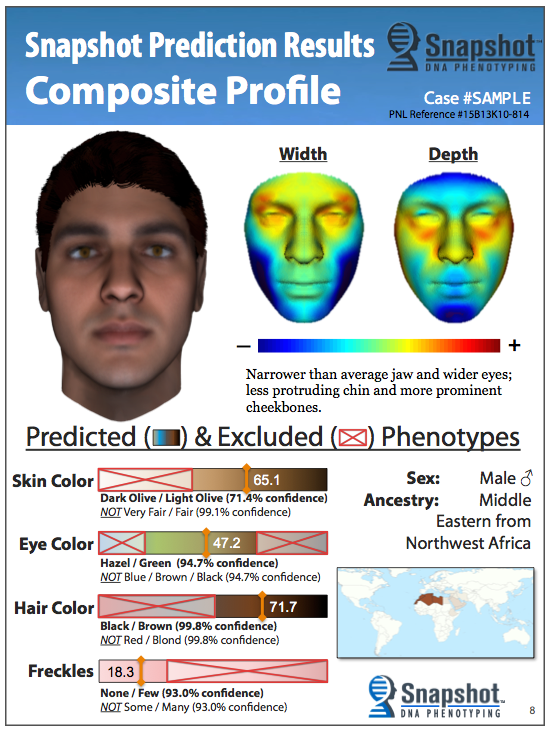

Snapshot works by using the DNA evidence found at the scene of a crime to generate a composite sketch of an individual based on genetic traits like facial structure, skin color, eye color, hair color and others.
Parabon NanoLabs (Parabon) announced today at the Academy of Forensic Sciences (AAFS) annual meeting in Orlando, Florida, a collaboration with Dr. Bruce Budowle, Executive Director of The Institute of Applied Genetics at the University of North Texas. Dr. Budowle will conduct a blinded validation of Parabon’s Snapshot™ DNA Phenotyping Service, a first-of-its-kind forensics offering that can interrogate an evidentiary DNA sample and produce an accurate composite image of the source.
Although major metropolitan police departments and federal agencies have privately validated Snapshot and are actively using the service, the collaboration announced today seeks to perform the first Snapshot validation study intended for peer-reviewed publication. Dr. Budowle, one of most widely published and respected names in DNA forensics, has ample experience validating forensic methods, having worked at the FBI Laboratory Division for over 25 years before moving to academia, where he has published nearly 500 articles and testified in over 250 criminal cases in the areas of molecular biology, population genetics, statistics, quality assurance and forensic biology.
“I am pleased to help validate the Snapshot service as I believe it has the potential to develop novel and invaluable investigative leads for law enforcement and missing persons identifications,” said Dr. Budowle. He added, “The accuracy of results on Parabon’s Snapshot, presented from private validation studies, are impressive and now warrant a formal study to document the results in a peer-reviewed journal. While the service is already assisting law enforcement, published validation results will help define and support its utility, and stimulate more rapid and widespread adoption of a remarkable technology.”
Dr. Budowle, having been directly involved in developing the quality assurance standards for the forensic DNA field, is uniquely qualified to lead the collaborative project. He has been a chair and member of the Scientific Working Group on DNA Methods, Chair of the DNA Commission of the International Society of Forensic Genetics and a member of the DNA Advisory Board. He was one of the original architects of the CODIS National DNA database, which maintains DNA profiles from convicted felons, from evidence in unsolved cases, and from missing persons.
Budowle and his research staff at the University of North Texas Health Science Center will design the study to simulate the workflow of typical cases where such technology will benefit, keeping the Parabon Snapshot team blind to the actual appearance of participants until the study ends. Dr. Ellen McRae Greytak, Director of Bioinformatics at Parabon, will lead the phenotyping portion of the effort and is confident about the outcome. Greytak explains, “The rigorous manner in which we develop the Snapshot models produces thousands of out-of-sample predictions on subjects from our reference database. By comparing these predictions with the true phenotypes, we objectively assess each model’s accuracy. Based on this ongoing internal validation and our success in other blinded validations, we know the results will be strong.” She adds, “Through this study with Dr. Budowle, we aim to formally document just how effectively Snapshot performs across a large and diverse cohort.”
The AAFS Annual Scientific Meeting, held February 16 – 21, 2015 at the Hyatt Regency Orlando, in Orlando, Florida will host over 5,000 forensic professionals from all 50 U.S. states and 70 countries to focus on forensic science education, mentorship and the future of the forensic sciences. Parabon NanoLabs will be exhibiting at booth 317, and Dr. Ellen McRae Greytak will be speaking at the event on Saturday, February 21st at 11:10 a.m. in the Windermere Ballroom X (Criminalistics Session 1). Dr. Greytak’s seminar on the Development of a Novel DNA Phenotyping System Using Genome-Wide SNP Data will focus on how this novel methodology for the discovery of significant SNPs for forensic traits and the development of those SNPs into predictive models for DNA phenotyping or kinship analysis will impact the forensic science community.

